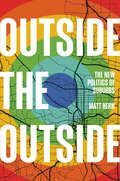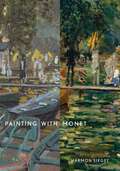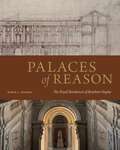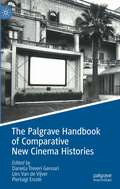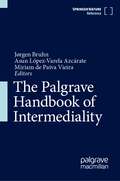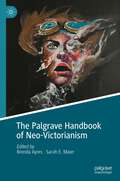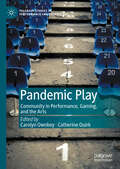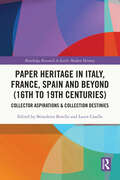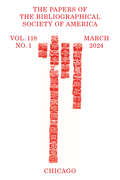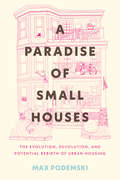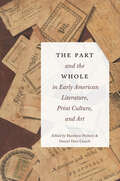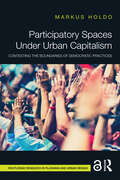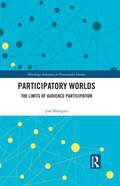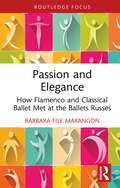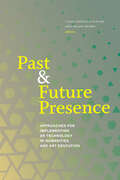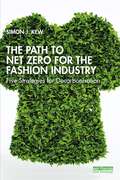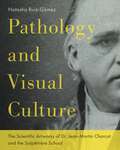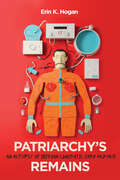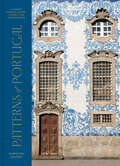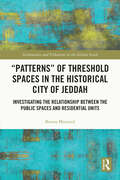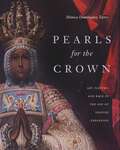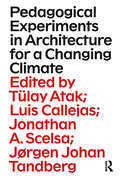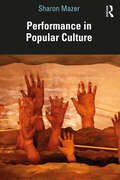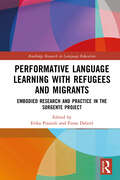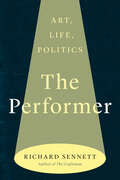- Table View
- List View
Outside the Outside: The New Politics of Suburbs
by Matt Hern"Matt Hern's brilliant and captivating Outside the Outside presents an urgently needed, theoretically sophisticated street-level perspective on some of the most pertinent ongoing critical debates about life and politics in our decentered suburban world."—Roger Keil, author of Suburban PlanetModern "sub-urbs" as a place of vibrancy, conflict and resistanceMatt Hern argues that the changing relationship between the urban center and the suburban periphery forces us to rethink the entire identity of the city itself. Today, most of the Western world lives on the city outskirts. Yet these neighborhoods that once offered security and respite from the perceived dangers of the city center have been radically transformed in the last few decades to poor, working-class and racialized communities. Outside the Outside maps these changes and argues for a revival of the social life of the city as a whole.Hern shows how language that relegates parts of the urban to the &“outside&” and designates other parts as the "center" echoes colonial forms of domination. This should come as no surprise in an era when communities are forced onto the periphery and beyond by gentrification.With on-the-ground reportage in, among other places, Vancouver, Portland, London, Ferguson and Rabat, Hern demonstrates how we need to challenge our misconceptions and see the "sub-urbs" as vibrant places of resistance and regeneration and to celebrate the movement, circulation and difference to be found there.
Painting with Monet
by Harmon SiegelA major reassessment of the methods and meaning of impressionismAt pivotal moments in his career, Claude Monet would go out with a fellow artist, plant his easel beside his friend&’s, and paint the same scene. Painting with Monet closely examines pairs of such works, showing how attention to this practice raises tantalizing new questions about Monet&’s art and about impressionism as a movement.Is impressionist painting an objective attempt to capture reality as it really is? Or is it a subjective expression of the artist&’s unique way of perceiving things? How can artists create a movement without conformity extinguishing individuality? Harmon Siegel reveals how Monet explored problems like these in concrete, practical ways while painting alongside his teachers, Eugène Boudin and Johan Barthold Jongkind; his friends, Frédéric Bazille and Pierre-Auguste Renoir; and his hero, Édouard Manet. At a time of major cultural upheavals, these artists asked how we can know reality beyond our personal perception. Siegel provides new insights into the aesthetic, philosophical, and ethical stakes for these painters as they responded to a rapidly changing society.Beautifully illustrated, Painting with Monet sheds critical light on how Monet and his fellow impressionists, painting side by side, professed their capacity to know the world and affirmed their belief in what Siegel calls the reality of others.
Palaces of Reason: The Royal Residences of Bourbon Naples
by Robin L. ThomasPalaces of Reason traces the fascinating history of three royal residences built outside of Naples in the eighteenth century at Capodimonte, Portici, and Caserta. Commissioned by King Charles of Bourbon and Queen Maria Amalia of Saxony, who reigned over the Kingdom of the Two Sicilies, these buildings were far more than residences for the monarchs. They were designed to help reshape the economic and cultural fortunes of the realm.The palaces at Capodimonte, Portici, and Caserta are among the most complex architectural commissions of the eighteenth century. Considering the architecture and decoration of these complexes within their political, cultural, and economic contexts, Robin L. Thomas argues that Enlightenment ideas spurred their construction and influenced their decoration. These modes of thinking saw the palaces as more than just centers of royal pleasure or muscular assertions of the crown’s power. Indeed, writers and royal ministers viewed them as active agents in improving the cultural, political, social, and economic health of the kingdom. By casting the palaces within this narrative, Thomas counters the assumption that they were imitations of Versailles and the swan songs of absolutism, while expanding our understanding of the eighteenth-century European palace more broadly.Original and convincing, Thomas’s book will be of interest to historians of art and architectural history and eighteenth-century studies.
The Palgrave Handbook of Comparative New Cinema Histories
by Daniela Treveri Gennari Lies Van de Vijver Pierluigi ErcoleThis Handbook offers new and previously unexplored comparative approaches to the field of New Cinema History. The volume brings together contributions focussing on historical and contemporary comparative case studies of cinema-going practices, cinema distribution, exhibition and reception from a global perspective. Engaging with a wealth of empirical and archive-based sources the volume explores a wide range of methodological and theoretical approaches. This Handbook is a key addition to debates on the relationship between film industry and cinema-going practices across different political and cultural geographical dimensions.
The Palgrave Handbook of Intermediality
by Jørgen Bruhn Asun López-Varela Azcárate Miriam de Paiva VieiraThis handbook provides an extensive overview of traditional and emerging research areas within the field of intermediality studies, understood broadly as the study of interrelations among all forms of communicative media types, including transmedial phenomena. Section I offers accounts of the development of the field of intermediality - its histories, theories and methods. Section II and III then explore intermedial facets of communication from ancient times until the 21st century, with discussion on a wide range of cultural and geographical settings, media types, and topics, by contributors from a diverse set of disciplines. It concludes in Section IV with an emphasis on urgent societal issues that an intermedial perspective might help understand.
The Palgrave Handbook of Neo-Victorianism
by Brenda Ayres Sarah E. MaierThis handbook offers analysis of diverse genres and media of neo-Victorianism, including film and television adaptations of Victorian texts, authors’ life stories, graphic novels, and contemporary fiction set in the nineteenth century. Contextualized by Sarah E Maier and Brenda Ayres in a comprehensive introduction, the collection describes current trends in neo-Victorian scholarship of novels, film, theatre, crime, empire/postcolonialism, Gothic, materiality, religion and science, amongst others. A variety of scholars from around the world contribute to this volume by applying an assortment of theoretical approaches and interdisciplinary focus in their critique of a wide range of narratives—from early neo-Victorian texts such as A. S. Byatt’s Possession (1963) and Jean Rhys’ Wide Sargasso Sea (1966) to recent steampunk, from musical theatre to slumming, and from The Alienist to queerness—in their investigation of how this fiction reconstructs the past, informed by and reinforming the present.
Pandemic Play: Community in Performance, Gaming, and the Arts (Palgrave Studies in Performance and Technology)
by Carolyn Ownbey Catherine QuirkWhen the arts, culture, and entertainment industries came to a halt in late winter 2020, many claimed this was the end of art as we knew it. Theatre managers, museum directors, performers, artists, and everyday folks had to figure out new strategies for living and thriving in a new world order. As the global pandemic and its consequences continue to play out, the question of how we have learned—as creators or consumers—to play, is far from settled. This collection addresses pandemic play in broad terms: how did creative industries adapt to a majority virtual world? How have our understandings of community and play evolved? Might new forms of art and play outlive the pandemic and supplant earlier iterations? Pandemic Play takes these questions as a starting point, exploring strategies, case studies, and effects of the arts worlds gone virtual.
Paper Heritage in Italy, France, Spain and Beyond: Collector Aspirations & Collection Destinies (Routledge Research In Early Modern History Ser.)
by Benedetta Borello Laura CasellaThis book takes a long-term approach, spanning from the end of the 16th to the 19th century, to explore how men and women in Italy, France, and Spain collected, displayed, and passed down various types of papers. The contributors share a core interest in the relationship between social actors and their paper heritage. The collectors, who come from diverse cultural, social, and gender backgrounds, provide insights into the reasons and processes behind the accumulation, valorisation, and transmission of their paper heritage. Unlike most studies on collecting, this book shifts the focus away from collections and institutions to the owners of the collected objects and their desires for their accumulated papers. This volume covers three centuries and provides insights into the aspirations of collectors and the fate of their papers after transmission. It takes place against the backdrop of major social, political, and cultural changes affecting the Italian peninsula, the Spanish monarchy, and France. The cultural interests and the collector networks often extended beyond Europe, as noted by many of the essays in this volume. Paper Heritage in Italy, France, Spain and Beyond (16th to 19th Centuries) will interest scholars and students of Early Modern and Modern European History across various fields, including social and cultural history, intellectual history, gender history, history of collecting and patronage.
The Papers of the Bibliographical Society of America, volume 118 number 1 (March 2024)
by The Papers of the Bibliographical Society of AmericaThis is volume 118 issue 1 of The Papers of the Bibliographical Society of America. Published on behalf of the oldest scholarly society in North America dedicated to the study of books and other textual artifacts in traditional and emerging formats, The Papers of the Bibliographical Society of America contains articles on book and manuscript production, publication, distribution, collecting, and reading in all periods, geographical regions, and media, as well as editorial and textual scholarship across all disciplines. The journal publishes original articles, book reviews, bibliographical notes, and review essays.
A Paradise of Small Houses: The Evolution, Devolution, and Potential Rebirth of Urban Housing
by Max PodemskiFrom the Haitian-style &“shotgun&” houses of the 19th century to the lavish high-rises of the 21st century, a walk through the streets of America&’s neighborhoods that reveals the rich history—and future—of urban housingThe Philadelphia row house. The New York tenement. The Boston triple-decker. Every American city has its own iconic housing style, structures that have been home to generations of families and are symbols of identity and pride. Max Podemski, an urban planner for the city of Los Angeles and lifelong architecture buff, has spent his career in and around these buildings. Deftly combining his years of experience with extensive research, Podemski walks the reader through the history of our dwelling spaces—and offers a blueprint for how time-tested urban planning models can help us build the homes the United States so desperately needs.In A Paradise of Small Houses, Podemski charts how these dwellings have evolved over the centuries according to the geography, climate, population, and culture of each city. He introduces the reader to styles like Chicago&’s prefabricated workers cottages and LA&’s car-friendly dingbats, illuminating the human stories behind each city&’s iconic housing type. Through it all, Podemski interrogates the American values that have equated home ownership with success and led to the US housing crisis, asking, &“How can we look to the past to build the homes, neighborhoods, and cities of the future that our communities deserve?&”
The Part and the Whole in Early American Literature, Print Culture, and Art (Transits: Literature, Thought & Culture, 1650-1850)
by Lori Rogers-Stokes Marion Rust Nicholas K. Mohlmann Daniel Diez Couch Keri Holt John Saillant D. Berton Emerson Laurel Hankins Lisa West Amy MorrisThe essays in this pathbreaking collection consider the significance of varied early American fragmentary genres and practices—from diaries and poetry, to almanacs and commonplace books, to sermons and lists, to Indigenous ruins and other material shards and fragments—often overlooked by critics in a scholarly privileging of the “whole.” Contributors from literary studies, book history, and visual culture discuss a host of canonical and non-canonical figures, from Edward Taylor and Washington Irving to Mary Rowlandson and Sarah Kemble Knight, offering insight into the many intellectual, ideological, and material variations of “form” that populated the early American cultural landscape. As these essays reveal, the casting of the fragmentary as aesthetically eccentric or incomplete was a way of reckoning with concerns about the related fragmentation of nation, society, and self. For a contemporary audience, they offer new ways to think about the inevitable gaps and absences in our cultural and historical archive.
Participatory Spaces Under Urban Capitalism: Contesting the Boundaries of Democratic Practices (Routledge Research In Planning And Urban Design Ser.)
by Markus HoldoCan people use new participatory spaces to reclaim their rights as citizens and challenge structures of political power? This book carefully examines the constraints and possibilities for participatory governance under capitalism. To understand what is at stake in the politics of participation, we need to look beyond the values commonly associated with it. Citizens face a dilemma: should they participate, even if this helps to sustain an unjust system, or not participate, thereby turning down rare opportunities to make a difference? By examining the rationale behind democratic innovation and the reasons people have for getting involved, this book provides a theory of how citizens can use new democratic spaces to challenge political boundaries. Connecting numerous international case studies and presenting original research from Rosario, Argentina, this book offers a crucial corrective to previous research. What matters most is not the design of new models of participation nor is it the supposed radical imagination of political leaders. It is whether people use new spaces for participation to renegotiate what democracy means in practice. Bridging critical urban studies and democratic theory, this book will be of interest to researchers and students in the fields of democratic innovations, political economy and urban planning. It will also provide activists and practitioners of participatory democracy with important tools to expand spaces of grassroots democracy.
Participatory Worlds: The limits of audience participation (Routledge Advances in Transmedia Studies)
by José BlázquezThis book is an in-depth analysis of participatory worlds, practices beyond the mainstream models of content production and IP management that allow audience members to contribute canonically to the expansion of storyworlds, blurring the line between the traditional roles of consumers and producers. Shifting discussions of participatory culture and cross-media production and consumption practices to more independent media contexts, the book explores the limits, borders and boundaries of participating in today’s digital media storyworlds. The text examines how audience participation works, identifying opportunities to make it a meaningful practice for audiences and an asset for IP owners, and discussing the challenges and barriers that the application of participatory culture brings along. The book defines what meaningful participation is by introducing the concept of ‘intervention’ and explains a range of factors impacting the way in which participatory worlds and relationships between producers, audiences and the world are shaped. This volume will be of great relevance to media practitioners, scholars and students interested in transmedia storytelling, fandom, literary studies and comparative literature, new media and digital culture, gaming and media studies.
Passion and Elegance: How Flamenco and Classical Ballet Met at the Ballets Russes (ISSN)
by Barbara File MarangonThis book commences with the history of Indian, Egyptian, Arab, and flamenco dance, then compares and contrasts the history of both classical ballet and flamenco.The book outlines the early roots of flamenco in India, and the journey of the Romani through the Middle East and Europe up to their final destination in Spain. Alongside this, the history of classical ballet is detailed from its beginning in Italy to its later development in France. The book spans the period from the temples of India to Massine’s Spanish ballet, The Three-cornered Hat, for the Ballets Russes. The chronicle of flamenco's journey from India to Spain is important to understanding the development of classical ballet as it relates to The Three-cornered Hat, which is the culmination of the story. The evolution of costumes, space, scenery, and props is examined along with the historical parallels.This exploration is set to inspire and encourage choreographers to partner other dance forms with ballet as Leonide Massine did with flamenco in The Three-cornered Hat while also challenging the anthropological idea of the language of dance movement tracing the migration of people.
Past and Future Presence: Approaches for Implementing XR Technology in Humanities and Art Education
by Lissa Crofton-Sleigh Brian BeamsWhile uses and studies of XR technology within STEM-based education have been plentiful in recent years, there has been lesser or even, at times, a lack of coverage for this novel learning tool in the arts and humanities.Past and Future Presence aims to bridge some of that gap by presenting research-based theory and case studies of successful application and implementation of XR technology into postsecondary educational settings, ranging in topics from ancient to modern languages, classical and contemporary art, and reenvisioned historical scenes and events presented in ways never seen before. The studies also contemplate how this novel medium can enhance and supplement learning in classrooms and other formal or informal learning environments. The volume as a whole is intended to demonstrate to educators, scholars, and researchers in higher education the potential value of integrating XR technology into their classrooms and to provide a strong argument for college and university administrators to invest in training and development of new research and content for classrooms inside and outside of STEM. The authors of these chapters come from a diverse range of backgrounds at different stages of their careers, providing a broad crosssection of scholastic work within the humanities and arts. Each chapter offers a different angle or approach to incorporating XR technology into teaching or research within different subject areas. As the volume suggests, this technology also places additional emphasis on the humanity within the humanities, by focusing on increasing connection between users and different cultures, time periods, and perspectives.
The Path to Net Zero for the Fashion Industry: Five Strategies for Decarbonisation
by Simon J. KewThis book uses a quantitative science-based approach to explain where the greenhouse gas (GHG) emissions emitted by the fashion industry are generated and it explores what strategies can be deployed to achieve Net Zero by 2050. With GHG emissions currently predicted to triple by the middle of the century, the fashion industry is far off course to reach Net Zero, as set out in the Paris Agreement. With misinformation and greenwashing representing an ever-growing barrier to potential solutions, the book aims to demystify the source of GHG emissions from the industry, breaking down in detail their origin, while identifying the steps that can be taken when designing and sourcing new products. Detailing the market drivers and trends in fashion consumption, it argues that change should be guided by science-based quantitative principles. Accessibly written with key insights at the end of each chapter, this book will enable the reader to understand the tactics to tackle decarbonisation, and ultimately outline five main strategies that can be deployed by the fashion and textile industries to align with the Paris Agreement. This book serves as a practical guide for designers, buyers and the fashion industry in general to develop and understand approaches and strategies to reduce energy consumption and the resulting GHG emissions to reach Net Zero.
Pathology and Visual Culture: The Scientific Artworks of Dr. Jean-Martin Charcot and the Salpêtrière School
by Natasha Ruiz-GómezIn this book, Natasha Ruiz-Gómez delves into an extraordinary collection of pathological drawings, photographs, sculptures, and casts created by neurologists at Paris’s Hôpital de la Salpêtrière in the nineteenth century. Led by Dr. Jean-Martin Charcot (1825–1893) and known collectively as the Salpêtrière School, these savants-artistes produced works that demonstrated an engagement with contemporary artistic discourses and the history of art, even as the artists/clinicians professed their dedication to absolute objectivity.During his lifetime, Charcot became internationally famous for his studies of hysteria and hypnosis, establishing himself as a pioneer in modern neurology. However, this book brings to light the often-overlooked contributions of other clinicians, such as Dr. Paul Richer, who created “scientific artworks” that merged scientific objectivity with artistic intervention. Challenging conventional interpretations of visual media in medicine, Ruiz-Gómez analyzes how these images and objects documented symptoms and neuropathology while defying disciplinary categorization.Grounded in extensive archival research, Pathology and Visual Culture targets an international audience of historians and students of art, visual culture, medicine, and the medical humanities. It will also captivate neurologists and anyone interested in fin-de-siècle French history and culture.
Patriarchy’s Remains: An Autopsy of Iberian Cinematic Dark Humour (McGill-Queen's Iberian and Latin American Cultures Series #8)
by Erin K. HoganSomething is rotten in the state of Spain. The uninterred corpse of a patriarchal figure populates the visual landscapes of Iberian cinemas. He is chilled, drugged, perfumed, ventilated, presumed dead, speared in the cranium, and worse.Analyzing a series of Iberian cinematic dark comedies from the 1950s to the present day, Patriarchy’s Remains argues that the cinematic trope of the patriarchal death symbolizes the lingering remains of the Francisco Franco dictatorship in Spain (1939–75). These films, created as satirical responses to persisting economic, social, and political issues, demonstrate that Spain’s transition to democracy following the Francoist period is an incomplete and ongoing process. Within the theme of patriarchal decay, the significance of the figure differs across cinematic representations, from his indispensability to his obstructionism and exploitation. Erin Hogan traces the prevalence of patriarchal death by analyzing its relationship with the surrounding characters who must depend on the deceased. Hogan demonstrates how the patriarch’s persistence in film both reveals and challenges an array of discriminations and inequalities in the cinematic grotesque tradition, in Iberian cinemas more broadly, and in Iberian society as a whole.Despite Spain’s ongoing transition towards democratic pluralism, Patriarchy’s Remains serves as a reminder that the remnants of an entrenched although not interred patriarchal culture continue to haunt Iberian society.
Patterns of Portugal: A Journey Through Colors, History, Tiles, and Architecture
by Christine ChitnisA vibrant tour of Portugal, featuring more than 200 photographs that bring to life one of the most beautiful countries in the world.In this gorgeous book, writer and photographer Christine Chitnis invites you to celebrate the unique, timeless beauty of Portugal through the stunning designs and hues that define Portugal&’s countryside, coast, small towns, and cosmopolitan cities.This collection features over 200 stunning photographs that illustrate the ways that color and pattern are woven into the very fabric of the country&’s culture, history, architecture, and traditions. Each section features insightful essays that explore the artistry of azulejos, the colorful ceramic tiles covering much of Portugal's architecture; the intricately embroidered details of traditional lavradeira costumes; the rich flavors of Portuguese cuisine, and so much more.Throughout these vibrant pages, you&’ll discover the vivid stories behind each color and pattern, transporting you to the gorgeous fields of Alentejo, the sparkling waters of the Algarve, the busy streets of Lisbon, the lush valleys of the Douro, and beyond.
“Patterns” of Threshold Spaces in the Historical City of Jeddah: Investigating the Relationship Between the Public Spaces and Residential Units (Architecture and Urbanism in the Global South)
by Basma Massoud“Patterns” of Threshold Spaces in the Historical City of Jeddah explores the meaning of threshold spaces and investigates the relationship between the public spaces and residential units in the historical city of Jeddah, Saudi Arabia, while at the same time revisiting Christopher Alexander’s theory in his canonical 1977 book, A Pattern Language. This book questions and analyses “patterns” relating to the cultural, social, and environmental particularities of Jeddah, with special attention paid to the effect of gender segregation in the city’s urban configuration. It discusses the extension that has been undertaken through testing a concept from the urban design theory of the West (the United States and Canada) and applying it to an Islamic city to find patterns in four different scales, which form the basis of the investigation (body, building, street, and city). Empirical methods have been used in the context of historical Jeddah, through which patterns are investigated using different approaches for the different scales. The book aims to explore the meaning of threshold spaces in old Jeddah. Furthermore, it shows that there are eighteen patterns of threshold spaces in the old town: patterns that are solely related to this specific case study, as well as modified patterns to the ones explored by Christopher Alexander. This book shall allow not only a better understanding of the relationship between housing and the historical city but also an exploration of the role of the threshold space in shaping the old city of Jeddah. It will be of interest to researchers, students of architecture, urban planning and anthropology studies, and people involved in cultural heritage, both academics and practitioners.
Pearls for the Crown: Art, Nature, and Race in the Age of Spanish Expansion
by Mónica Domínguez TorresIn the age of European expansion, pearls became potent symbols of imperial supremacy. Pearls for the Crown demonstrates how European art legitimated racialized hierarchies and inequitable notions about humanity and nature that still hold sway today.When Christopher Columbus encountered pristine pearl beds in southern Caribbean waters in 1498, he procured the first source of New World wealth for the Spanish Crown, but he also established an alternative path to an industry that had remained outside European control for centuries. Centering her study on a selection of key artworks tied to the pearl industry, Mónica Domínguez Torres examines the interplay of materiality, labor, race, and power that drove artistic production in the early modern period. Spanish colonizers exploited the expertise and forced labor of Native American and African workers to establish pearling centers along the coasts of South and Central America, disrupting the environmental and demographic dynamics of their overseas territories. Drawing from postcolonial theory, material culture studies, and ecocriticism, Domínguez Torres demonstrates how, through use of the pearl, European courtly art articulated ideas about imperial expansion, European superiority, and control over nature, all of which played key roles in the political circles surrounding the Spanish Crown.This highly anticipated interdisciplinary study will be welcomed by scholars of art history, the history of colonial Latin America, and ecocriticism in the context of the Spanish colonies.
Pedagogical Experiments in Architecture for a Changing Climate
by Tülay Atak Luis Callejas Jonathan Scelsa Jørgen TandbergThis book presents a series of pedagogical experiments translating climate science, environmental humanities, material research, ecological practices into the architectural curriculum. Balancing the science and humanities, it exposes recent pedagogical experiments from renown educators, while also interrogating a designer’s agency between science and speculation in the face of climate uncertainty. The teaching experiments are presented across four sections: Abstraction, Organization, Building, and Narrative, exposing core parts of an architect’s education and how educators can simultaneously provide fundamental skills and constructive literacy while instigating environmental sensibilities. Chapters cover issues such as an unstable hydrosphere, water infrastructure, remediating materials, methods of disassembly and adaptive reuse, as well as constructing new aesthetic categories of climate change, and implementing oral histories of construction, among many others. Written and edited by expert design educators actively engaged in experimenting in new forms of pedagogy, this book will be of great use to architecture instructors at all levels looking to renew their teaching practices to more directly address the climate emergency. It will also appeal to those academics across the built environment interested in the ways design can affect and adapt to climate change.
Performance in Popular Culture
by Sharon MazerPerformance in Popular Culture reveals the intricate relationship between performance and popular culture by exploring how theatrical conventions and dramaturgical tropes have informed the way the social is constructed for popular consumption. Staged as a series of case studies, this book considers the diverse ways the social is imagined and produced in live and mediated performances, in images and texts, in interactive experiences and in cultural institutions. By looking at performance in popular culture, the world we live in becomes more visible, open to investigation and (perhaps) to change. Performance in Popular Culture engages a wide range of disciplines and theoretical frameworks: performance, theatre and cultural studies; comparative literature and media studies; gender and sexuality, critical race and post-colonial theories. Designed for accessibility at an undergraduate level, the case studies make use of visual materials, moving images and texts that are readily available to lecturers and students, to scholars and to the general public.
Performative Language Learning with Refugees and Migrants: Embodied Research and Practice in the Sorgente Project (Routledge Research in Language Education)
by Erika Piazzoli Fiona DalzielThis book investigates the use of performative language pedagogy in working with refugees and migrants, exploring performative language teaching as the application of drama, music, dance and storytelling to second language acquisition.Documenting a community-based project – funded by the Irish Research Council and conducted with three groups of refugees and migrants in Ireland and Italy – the book explores the methodological, pedagogical and ethical elements of performative language learning in the context of migration. Written by a team of arts-based researchers and practitioners, chapters discuss findings from the project that relate to factors such as embodied research methods, a motivation to belong and the ethical imagination, while exhibiting how performative language pedagogy can be effective in supporting children and adults in a range of challenging contexts.Offering a poetic and pictorial representation of the Sorgente Project, this book will be of interest to postgraduate students, researchers and academics in the fields of English language arts and literacy education, drama in education, the sociology of education and second language acquisition more broadly. Those working in refugee and migrant studies, and teacher education studies will also find the volume of use.
The Performer: Art, Life, Politics
by Richard SennettAn acclaimed sociologist&’s exploration of the connections among performances in life, art, and politics In The Performer, Richard Sennett explores the relations between performing in art (particularly music), politics, and everyday experience. It focuses on the bodily and physical dimensions of performing, rather than on words. Sennett is particularly attuned to the ways in which the rituals of ordinary life are performances. The book draws on history and sociology, and more personally on the author&’s early career as a professional cellist, as well as on his later work as a city planner and social thinker. It traces the evolution of performing spaces in the city; the emergence of actors, musicians, and dancers as independent artists; the inequality between performer and spectator; the uneasy relations between artistic creation and social and religious ritual; the uses and abuses of acting by politicians. The Janus-faced art of performing is both destructive and civilizing.
